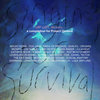Plausibly Live by Steev Hise
Tracklist
| 1. | Mojito Kit | 2:38 |
| 2. | Critical Interlude | 0:29 |
| 3. | Connotation Space | 7:30 |
| 4. | A Fight Club for Swooners | 4:49 |
| 5. | Insanity | 4:15 |
| 6. | International | 4:24 |
| 7. | Database vs. Narrative | 3:26 |
| 8. | Free-Floating Signifiers | 6:03 |
| 9. | What's the difference between a laptop performer and a lapdance performer? | 8:47 |
| 10. | Violence to the Texts | 7:02 |
| 11. | 10,000 Year Blight | 6:46 |
| 12. | Omniguitar Freakstory | 16:36 |
Credits
released October 8, 2014
Additional performers:
Bob Boster (CD players, eletronics), Merlin Coleman (vocals), Scott Looney (electronics), Wobbly (Jon Leidecker) (electronics), Ryan Francesconi (software), and the Evolution Control Committee (Mark Gunderson)(Thimbletron)
Instruments used by Steev:
The Sampletar (tracks 1-4 and 12)
An instrument consisting of three components: a guitar with MIDI interface, a sampler, and a computer running software written by me in HMSL (Hierarchical Music Specification Language). The software takes MIDI note information from the guitar and maps it to loop points in a bank of samples, so that essentially I can assing a 14 second chunk of sound to each string of the guitar, and index into a sound depending on where I fret on that string. Controller knobs were also mapped to things like LFO resonance frequency and cutoff.
Stampede (tracks 5, 6, 9)
Granular synthesis software for the SGI Indy platform, written by Gerhard Behle. Granular Synthesis is one of my favorite techniques, and this software is a quite nice implementation of it, giving the user 16 different parameters to tweak in real time. Hours of fun.
The Syntagm Engine (tracks 7, 8, 9, 10, 11)
An attempt to solve the following problem: How does one combine a performative practice of non-idiomatic free improvisation with an aesthetic of critical sound collage (critical in the sense of detournement, the removal of a piece of culture from its original context and its placement in a new context with the purpose of commenting on or critiquing that material or its origins)?^MOne answer: a relational database of sounds categorized by several variables (like intensity, "rhythmicness", "semiotic density", etc.) which can be easily queried to present source material that is connected. Hence a wide variety of material is available to be juxtaposed and organized via many possible relationships, though the relationships are chosen dynamically by the player. The name of this new instrument derives from the field of semiotics, in which a syntagm is defined to be a sequence of signs. A traditional example of a syntagm is a sentence, such as "man bites dog." Of course the words, or signs, in this sentence can be rearranged to form a new syntagm with a different meaning, like "dog bites man." Similarly, the Syntagm Engine is a tool for quickly forming sequences of sonic signs. The Syntagm Engine consists of about 7000 lines of Perl, SQL, and Csound code which run on a Linux laptop. I first performed with it in May 2000 at the San Francisco Electronic Music Festival. Much of the same code went into the Detritus Sound Concensus Bakery, an internet sound installation (soundbakery.detritus.net) funded by New Langton Arts that same year.
Additional performers:
Bob Boster (CD players, eletronics), Merlin Coleman (vocals), Scott Looney (electronics), Wobbly (Jon Leidecker) (electronics), Ryan Francesconi (software), and the Evolution Control Committee (Mark Gunderson)(Thimbletron)
Instruments used by Steev:
The Sampletar (tracks 1-4 and 12)
An instrument consisting of three components: a guitar with MIDI interface, a sampler, and a computer running software written by me in HMSL (Hierarchical Music Specification Language). The software takes MIDI note information from the guitar and maps it to loop points in a bank of samples, so that essentially I can assing a 14 second chunk of sound to each string of the guitar, and index into a sound depending on where I fret on that string. Controller knobs were also mapped to things like LFO resonance frequency and cutoff.
Stampede (tracks 5, 6, 9)
Granular synthesis software for the SGI Indy platform, written by Gerhard Behle. Granular Synthesis is one of my favorite techniques, and this software is a quite nice implementation of it, giving the user 16 different parameters to tweak in real time. Hours of fun.
The Syntagm Engine (tracks 7, 8, 9, 10, 11)
An attempt to solve the following problem: How does one combine a performative practice of non-idiomatic free improvisation with an aesthetic of critical sound collage (critical in the sense of detournement, the removal of a piece of culture from its original context and its placement in a new context with the purpose of commenting on or critiquing that material or its origins)?^MOne answer: a relational database of sounds categorized by several variables (like intensity, "rhythmicness", "semiotic density", etc.) which can be easily queried to present source material that is connected. Hence a wide variety of material is available to be juxtaposed and organized via many possible relationships, though the relationships are chosen dynamically by the player. The name of this new instrument derives from the field of semiotics, in which a syntagm is defined to be a sequence of signs. A traditional example of a syntagm is a sentence, such as "man bites dog." Of course the words, or signs, in this sentence can be rearranged to form a new syntagm with a different meaning, like "dog bites man." Similarly, the Syntagm Engine is a tool for quickly forming sequences of sonic signs. The Syntagm Engine consists of about 7000 lines of Perl, SQL, and Csound code which run on a Linux laptop. I first performed with it in May 2000 at the San Francisco Electronic Music Festival. Much of the same code went into the Detritus Sound Concensus Bakery, an internet sound installation (soundbakery.detritus.net) funded by New Langton Arts that same year.







